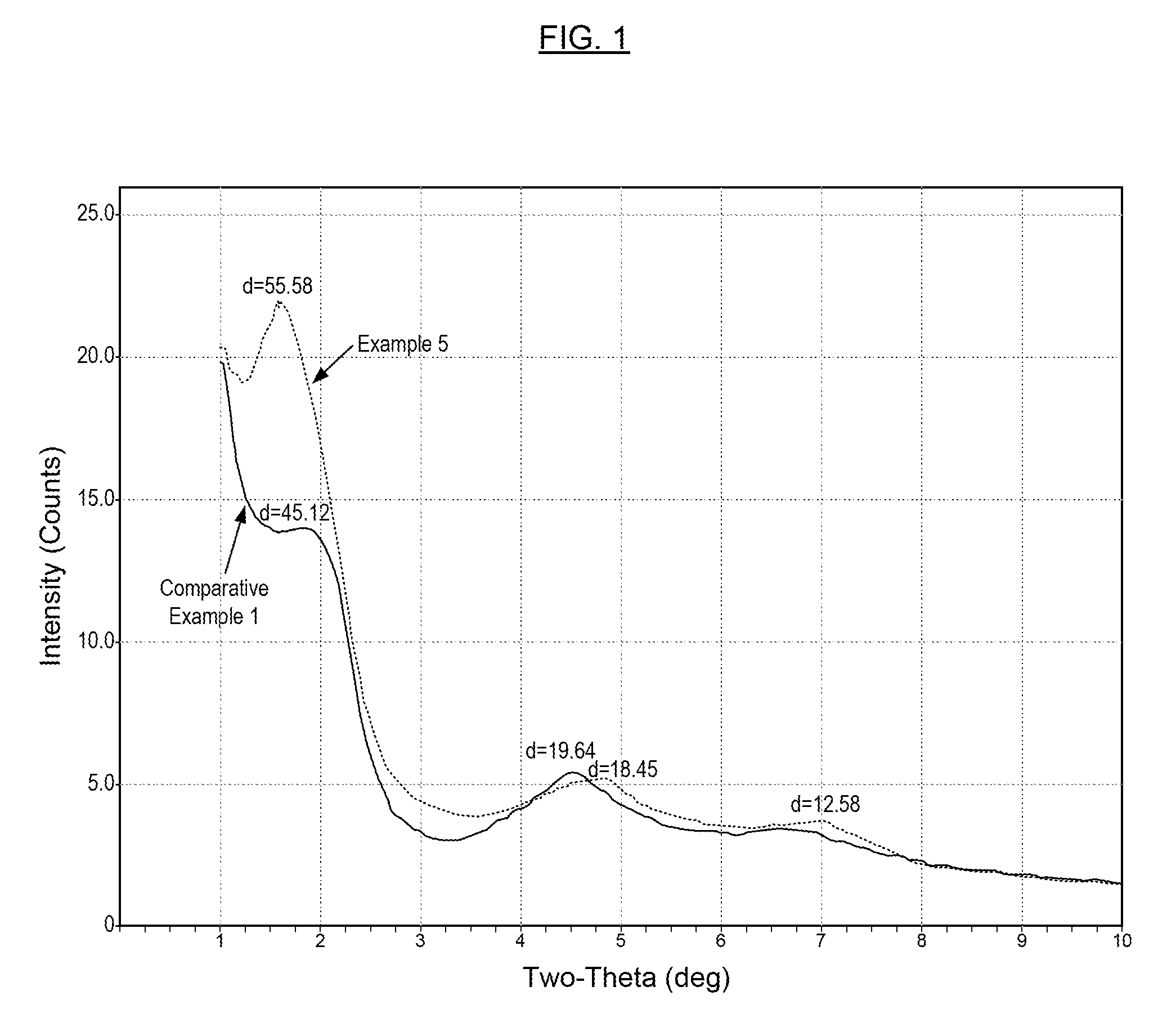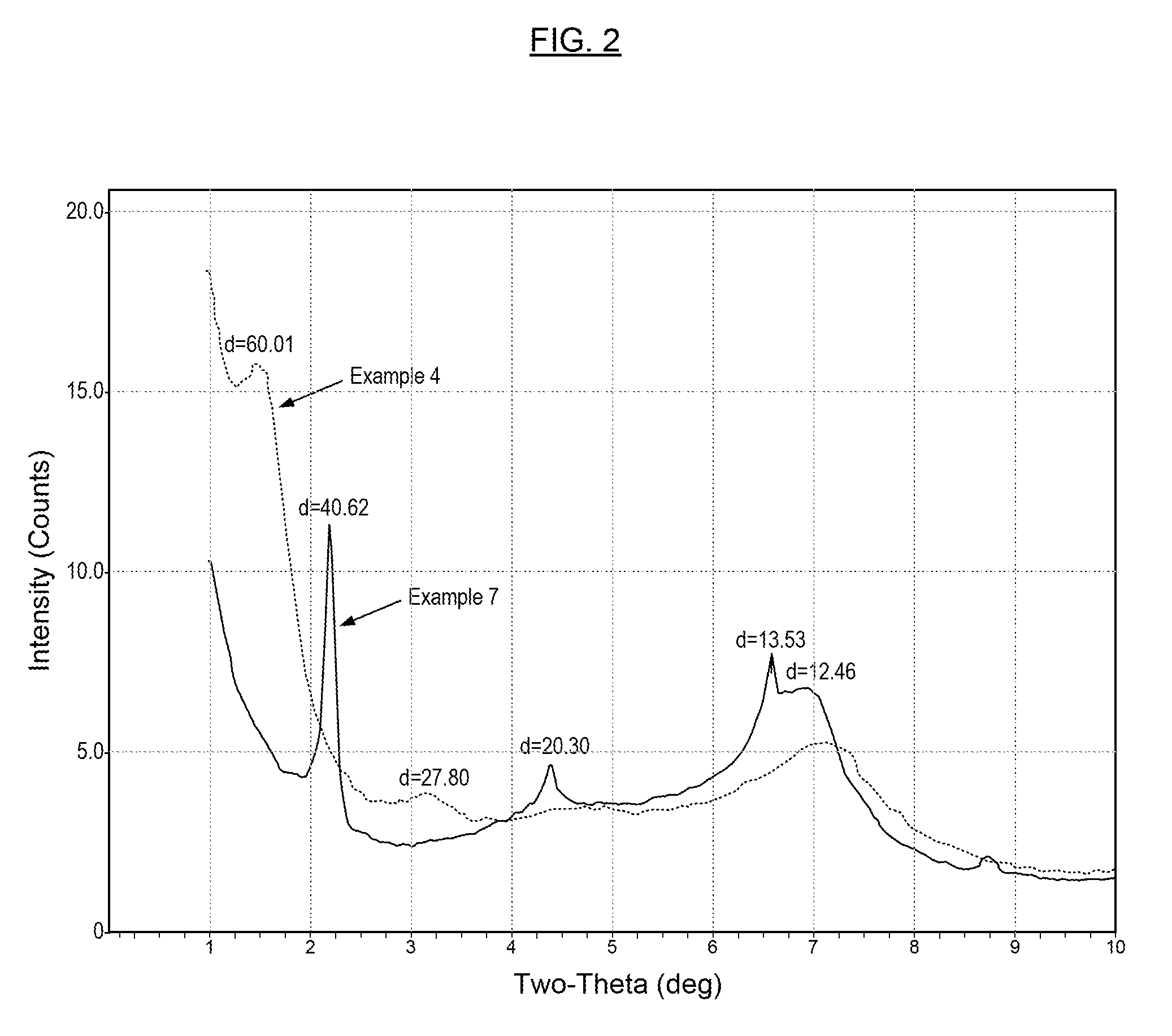Metal Carboxylate Clays, Derivatives of Metal Carboxylate Clays, Methods for Making the Same, and Compositions Containing the Same
- Summary
- Abstract
- Description
- Claims
- Application Information
AI Technical Summary
Benefits of technology
Problems solved by technology
Method used
Image
Examples
example 1
Preparation of Zinc Clay RA and Zinc Organoclay RAA
[0056]Zinc ammonia carbonate complex solution (12,000 grams) was prepared, having 8.94% zinc (using technical grade zinc oxide), 10.10% ammonia, and 6.03% carbon dioxide. Slowly, bentonite Pc7 (10,000 grams) was added into 100 liters of water with good agitation, and the mixture was stirred for two hours. The resulting solution was de-gritted with a 325 mesh screen. Then the zinc ammonia carbonate complex solution was added slowly into the solution-like bentonite slurry while continue to agitate. The resulting zinc clay slurry was attrition milled for two hours and then boiled to eliminate substantially all of the ammonia and most of the carbon dioxide. The zinc clay was filtered, then dried at 170° C. The dried cake was attrition milled and sieved through a 200 mesh screen. The zinc clay has the following properties:
No.Bulk DensityZinc %D001 Spacing, AngstromsRA0.8310.2912.3**
[0057]A quaternary ammonium chloride is added to the abo...
example 2
Preparation of Zinc Stearate Clay
[0059]Stearic acid (75 grams) was added to 500 gram of zinc clay RA. The mixture was attrition milled for two hours and then heated at 150° C. for one more hour. The product again was attrition milled and then jet milled through a CJ-10 jet mill manufactured by Nisshin Engineering Co. Ltd. of Japan. The final product was sieved through a 200 mesh sieve to produce zinc stearate clay RB. There is some loss of material through dusting at the various milling processes. Its properties are listed below:
No.Bulk DensityZinc %D001 Spacing, AngstromsRB0.459.141.7
example 3
Preparation of Zinc Stearate Clay Via Ammonium Stearate
[0060]An ammonium stearate solution was prepared by mixing 113.5 grams of stearic acid with 567 grams of ammonia / carbon dioxide solution containing 12% of ammonia and 10% of carbon dioxide. The solution was sprayed onto 756 grams of zinc clay R591, then the mixture was mixed well and heated to 60° C. The resulting powder was heated at 110° C. for 18 hours. The dried powder was attrition milled again and then sieved with a 140 mesh sieve. The product was jet milled with the Nissen jet mill (see Example 2) to produce zinc stearate clay RC. There is some loss of material through dusting at the various milling processes. Its properties are listed below:
No.Bulk DensityZinc %D001 Spacing, AngstromsRC0.339.7147.7
PUM
| Property | Measurement | Unit |
|---|---|---|
| Fraction | aaaaa | aaaaa |
| Percent by mass | aaaaa | aaaaa |
| Temperature | aaaaa | aaaaa |
Abstract
Description
Claims
Application Information
 Login to View More
Login to View More - R&D
- Intellectual Property
- Life Sciences
- Materials
- Tech Scout
- Unparalleled Data Quality
- Higher Quality Content
- 60% Fewer Hallucinations
Browse by: Latest US Patents, China's latest patents, Technical Efficacy Thesaurus, Application Domain, Technology Topic, Popular Technical Reports.
© 2025 PatSnap. All rights reserved.Legal|Privacy policy|Modern Slavery Act Transparency Statement|Sitemap|About US| Contact US: help@patsnap.com


